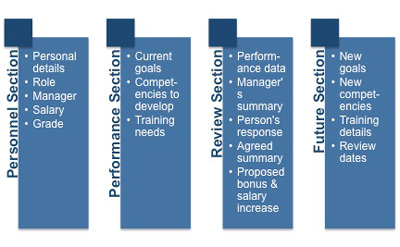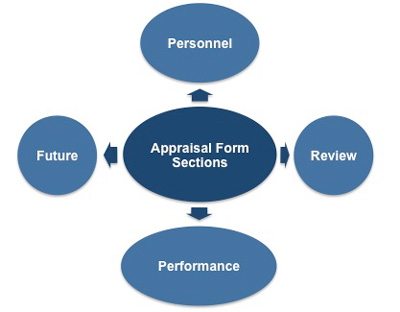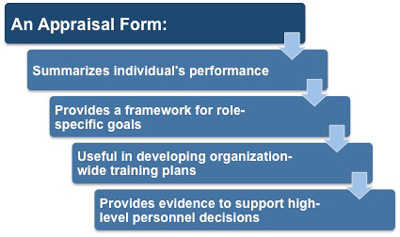Appraisal Forms Format
The first five stages of the appraisal process are covered as part of the meeting and should each be reflected in the appraisal form. The form should consist of four main sections that record all the necessary information for an appraisal.
The four sections are:
• Personnel
• Performance
• Review
• Future
The form must also include an area where you and the individual can sign your agreement to the written summary of that section. The form also provides you with an agenda for the meeting, ensuring that you remember all the key aspects of the appraisal and helping you to form your opening statement.
 |
By using a form with all of these sections you will make certain that you have a complete record of everything that occurred throughout the whole appraisal process. The terminology used by your organization may be different, but the essence and contents of each section are essentially the same.
The first section, 'Personnel,' should include the individual's name, date of birth, job title and grade, current salary, department, manager, and salary band for grade.
The second section, 'Performance,' should detail the team member's current goals along with the relevant measures and timescales. Then it should also list the competencies that the individual is developing. You will need to detail the names and schedules of courses, on-the-job training, or mentoring that is required to attain these goals and competencies.
 |
The third section, 'Review,' is the one that will form the main thrust of the appraisal meeting and is the section that will be completed at the conclusion of the meeting.
This section contains:
1. A summary of the individual's performance as written by you.
2. The team member's written response to your summary.
3. The performance data you have collected over the appraisal period in order to provide the supporting evidence you will use to back up your summary.
By exchanging each other's rating of performance prior to the meeting you can both fully prepare for the discussions that are likely to occur and know the extent to which you agree or not!
One thing you should do when reviewing the team member's written response to your summary is to look for any indication that the team member feels as though either:
- The appraisal process lacks legitimacy because the performance data on which it is based is incomplete or selective.
- You have no genuine interest in them and the whole thing is simply an administrative necessity you both would rather not have to bother with.
Unfortunately, this does happen occasionally and it is usually a result of a busy manager not being seen to take an interest in a team member's performance during the year. Imagine yourself as a hard-working team member dealing with problems day after day, getting very little recognition for it, and submitting reports to their manager about which they never receive any feedback.
Suddenly, they are notified of an appraisal meeting and their first reaction is 'Who does this person think they are to judge my work? Do they know what I actually do? How much do they even care?'
Now you may feel that this is unfair; after all, managers are busy people with their own duties and responsibilities. But if you don't spend sufficient time being seen to take an interest in your team members then you can expect to get this reaction from time to time. If this happens then it is obviously a sign that the team member is feeing 'disengaged,' something that needs to be addressed immediately and guarded against in the future. In the short term you should meet with the team member with the specific purpose of talking through the issue and trying to get to the bottom of why they feel the way they do and to ask them what can be done to remedy the situation.
If this level of disengagement has been allowed to develop then you may need to accept some responsibility for it and take steps to prevent it from recurring. If you choose not to address it before the appraisal meeting then the meeting will only serve to alienate the team member even more as they are forced to take part in something which they feel lacks any legitimacy.
It is these three things - data and the two summaries - that you will discuss and agree with the individual in the final wording and rating of their performance. You will add your signatures to this as formal acceptance.
Finally in this section you should also detail any discussions you have had concerning a bonus, change in remuneration, or pay grade. This is also where you would record any disagreements or formal disciplinary actions that result from the appraisal meeting.
The fourth section, 'Future,' is concerned with the coming year and it is here that you would detail the new goals and required competencies you have discussed with the individual and gained their agreement to. This is also where you would specify the necessary training and development to be offered to the person to assist them in attaining their goals.
It is within this section that you will diarize the regular review dates to monitor their performance throughout the forthcoming appraisal period. These meetings also provide an excellent and essential opportunity for feedback to be exchanged between you and your team member. These reviews enable you to avoid surprises by providing you with ample opportunity to address poor performance as soon as it becomes evident.
If the form your organization uses does not include or allow for each of these items then you should add separate sheets to the supplied form in order to ensure that you have a complete record of the discussions that took place in the meeting. This can prove to be a lifesaver if you ever need to justify or defend your decisions at a future date.
This completed form is then copied to the employee as well as being placed in their personnel file. It also provides an effective way to highlight an employee's performance from the last review or date of hire to the present in relation to the requirements and responsibilities identified in the job description.
 |
The most common function of the appraisal form is to present a summary of performance, but they can also provide the necessary information to help develop an individual's career path and ascertain whether or not promotion or a pay rise is appropriate.
The form also enables organizations to:
• Provide evidence and a framework for role-specific goals
• Develop organization-wide training plans
• Provide evidence to support high-level personnel decisions
The ideal performance appraisal form combines descriptive terms that require supporting narrative with sufficient space for employees to comment on their manager's evaluation.
You can download a sample appraisal form template from this website as well as other templates and checklists to help you with the appraisal process.
You may also be interested in:
Appraisal Meeting Tips | Appraisal Meeting Structure | Past Performance Evaluation | Appraisal Goals and Objectives | Appraisal Discussion Points.



